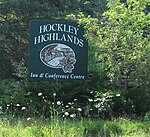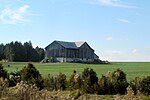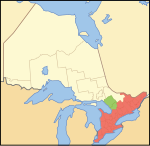The Province of Upper Canada (French: province du Haut-Canada) was a part of British Canada established in 1791 by the Kingdom of Great Britain, to govern the central third of the lands in British North America, formerly part of the Province of Quebec since 1763. Upper Canada included all of modern-day Southern Ontario and all those areas of Northern Ontario in the Pays d'en Haut which had formed part of New France, essentially the watersheds of the Ottawa River or Lakes Huron and Superior, excluding any lands within the watershed of Hudson Bay. The "upper" prefix in the name reflects its geographic position along the Great Lakes, mostly above the headwaters of the Saint Lawrence River, contrasted with Lower Canada (present-day Quebec) to the northeast.
Upper Canada was the primary destination of Loyalist refugees and settlers from the United States after the American Revolution, who often were granted land to settle in Upper Canada. Already populated by Indigenous peoples, land for settlement in Upper Canada was made by treaties between the new British government and the Indigenous, exchanging land for one-time payments or annuities. The new province was characterized by its British way of life, including bicameral parliament and separate civil and criminal law, rather than mixed as in Lower Canada or elsewhere in the British Empire. The division was created to ensure the exercise of the same rights and privileges enjoyed by loyal subjects elsewhere in the North American colonies. In 1812, war broke out between Great Britain and the United States, leading to several battles in Upper Canada. The United States attempted to capture Upper Canada, but the war ended with the situation unchanged.
The government of the colony came to be dominated by a small group of persons, known as the "Family Compact", who held most of the top positions in the Legislative Council and appointed officials. In 1837, an unsuccessful rebellion attempted to overthrow the undemocratic system. Representative government would be established in the 1840s. Upper Canada existed from its establishment on 26 December 1791 to 10 February 1841, when it was united with adjacent Lower Canada to form the Province of Canada.






